Legal structure as a design instrument
- Written by: Matthew Griffin |
- Created: Tuesday, 22 November 2016 11:13
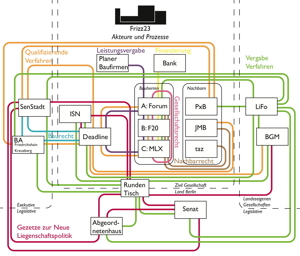
This article deals with the evolving relationship between architecture and legislation based on our experience as architects and our work on Frizz23, one of the three projects selected for the three PxB sites surrounding the Blumengroßmarkt.
As architects operating beyond the envelope of traditional practice, we see no difference between solving a design problem, and resolving pre-structural issues like the legal fabric this article focuses on.
The attached diagram shows the different layers of interaction between the network of actors involved in Project Frizz23, and the pertinent legislation. We pursued different strategies within each layer to either make the law conform to the project, or make the project conform to the law.
1. Actively changing Legislation
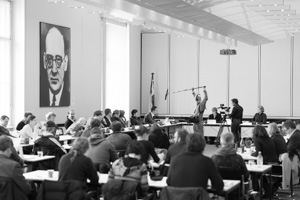
Working as participants within the Initiative Stadt Neudenken we have helped structure Berlin's legislation for public land sales by means of a broad dialogue between civil society and government institutions. The processes that lie behind changing legislation are incremental and slow. The negotiations at the Rundentisch zur Liegenschaftspolitik which began in 2012 are progressing, but much is yet to be accomplished.
The land sales procedure established for the three PxB sites is a critical milestone in the process of changing Berlin's Liegenschaftspolitik. The pilot procedure evolved, was refined step by step, and culminated in an exhibition and public workshop that informed the selection of the best project for each site. As a case study it informs and inspires the ongoing work to improve Berlin's legislation governing public land sales.
Changing legislation takes longer than the design and construction phases of a building. As architects we are usually confined to working within the existing legal framework, contributing to incremental change by providing innovative examples.
2. Developing references for future Legislation
The three projects that the jury selected to buy the three sites were all based on innovative cooperative development models led by architects. State regulations specified that a requirement for an architectural competition be written into the land sale contract. We proposed a new dialogue oriented alternative, and together with all stakeholders negotiated a change in the contracts.
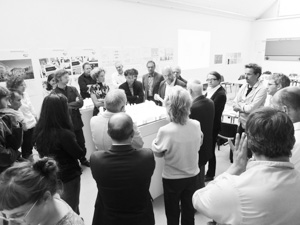
This Qualifizierende Verfahren (qualifying procedure) spanned four workshops and 18 months in which the state and district urban planing departments, three invited external architects, representatives of local initiatives, and the clients and architects of the three sites criticized and encouraged the successively evolving designs. This intense dialogue provided a unique non competitive framework to assure architectural quality, and build consensus and support for the proposals. It promoted deep interaction between the stakeholders and architects as the projects evolved. The process created an environment that fostered outstanding participative design.
This Qualifizierende Verfahren precedent serves as a reference for adapting legislation to encourage dialogue oriented design as a viable, co-operative alternative to an architectural competition.
3. Expanding the envelope of existing legislation
The Qualifizierende Verfahren gave us the chance to explore the architectural potential beyond the envelope specified by the Bebauungsplan. During the workshops we were able to draw on a broad panel of experts to help negotiate exceptions that would have been difficult under normal circumstances.
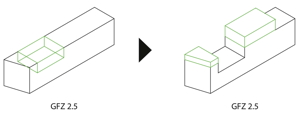
To realize the Frizz23 building as planned, we needed seven significant exceptions from the Bebauungsplan. The most visible of which was permission to substantially exceed height requirements so we could create the project's distinctive silhouette by redistributing the permissible floor area.
Economically driven projects do not normally seek exceptions to these laws because of the time required and the risk involved. This tends to foster to buildings defined primarily by regulations instead of expressing richer architectural priorities.
4. Designing legal structures to accommodate architectural potential
To make Frizz23 possible, we created a two tiered ownership structure.
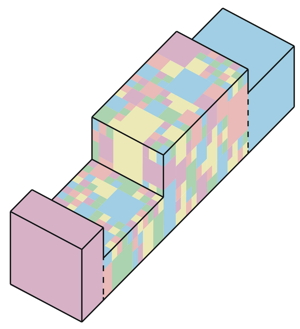
The outer layer was a building co-operative consisting of three separate sites for three companies, each with its own distinct ownership structure: Forum Berufsbildung e.V. a charitable company specialized in education, Miniloft Kreuzberg GbR in which were engaged as owners in addition to our role as architects, and FrizzZwanzig GbR a building co-operative that we founded to shoulder the lions share of the project.
To include Forum Berufsbildung e.V. in the project, we needed to comply with the complex and strict legislation governing charitable organizations. We consulted several experts to help us define a structure at the intersection of tax, ownership and planning law that would make the building possible.
The architecture is an expression of this complex ownership structure – Einteilig, Dreiteilig Kleinteilig (single-, triple-, multifaceted)
5. Legislation adapting to design
The co-operative Baugruppen projects developed by architects exploring new models for architectural production have exposed cracks in existing German legislation.
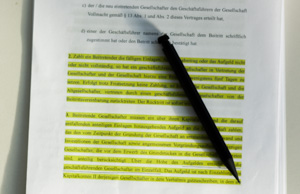
The courts have asked the federal government to redefine property purchase tax laws to cover the specifics of the Baugruppen model. Working with experts we established a contract for FrizzZwanzig GbR not only as the basis upon which to create a community, but also to minimize the risk involved. One major challenge in this is to design for yet unknown changes in projected legislation which will happen soon after construction is completed, and which may affect the project.
When a project steps beyond the standard models, designing the legal structures is a challenge often left to lawyers. By exploring the potential of the legal framework as a design instrument, architects can expand their radius of action, and gain more control of their work.
This post began as a proposal for the legislating architecture issue of ARCH+